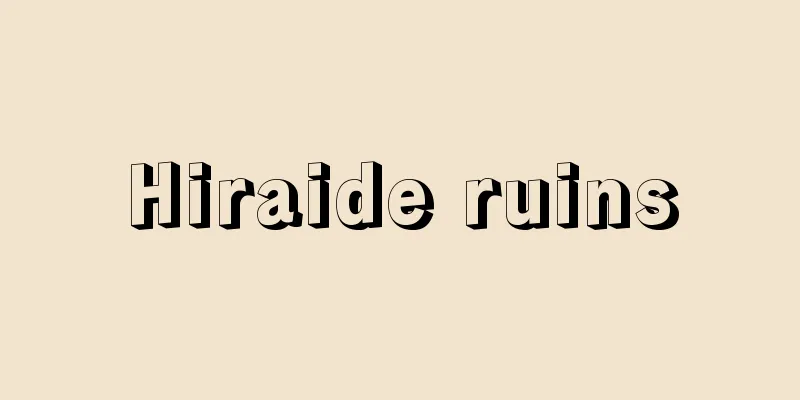Hiraide ruins

|
These are the remains of a primitive and ancient settlement centered around Hiraide (formerly Soga Village) in Shiojiri City, Nagano Prefecture. It is located on the alluvial fan plateau of the Narai River, at the southern end of the Matsumoto Basin. It is a representative settlement site that includes the remains of pit dwellings and raised-floor storehouses from the Kofun period through to the Heian period, as well as the remains of pit dwellings from the middle Jomon period and stone-arranged sites related to religious practices. In 1949 (Showa 24), a research committee was established at the village office, and a comprehensive survey of archaeology, ancient history, geography and folklore was carried out over a four-year period, led by Oba Iwao. Among the excavated remains, a green-glazed water jar is known as a fine product from the early Heian period, and the large amount of ash-glazed pottery from Tono well indicates the state of economic distribution in ancient times. Natural remains such as rice, barley, and broad beans attracted attention. Pit dwellings and raised-floor storehouses from the Kofun period have been restored, and the excavated remains are stored and exhibited at the Shiojiri City Hiraide Museum. After the Second World War, around the time of the investigation of the Toro ruins (Shizuoka), many universities participated in various research fields to carry out joint research, exploring the future of local history research, and in the area of archaeology in particular, many groundbreaking attempts were made to grasp the extent of the ruins, restore their ancient history, and set up a ruins museum to preserve them, making this a significant event in the history of academics. The ruins were designated a national historic site in 1952. [Yoshiharu Koide] Source: Shogakukan Encyclopedia Nipponica About Encyclopedia Nipponica Information | Legend |
|
長野県塩尻(しおじり)市平出(旧宗賀(そうが)村)を中心に営まれた原始・古代の集落遺跡。松本盆地の南端、奈良井川の扇状台地上にある。古墳時代から平安時代に及ぶ竪穴(たてあな)住居址(し)、高床倉庫址などを中心に、縄文中期の竪穴住居址や信仰に関係ある配石址を含む代表的集落址である。1949年(昭和24)村役場に調査会が置かれ、大場磐雄(いわお)を団長に4か年にわたって考古、古代史、地理、民俗各分野の総合的調査が行われた。 出土遺物では、緑釉水瓶(りょくゆうすいびょう)が平安初期の優品として知られ、また東濃産の大量の灰釉(かいゆう)陶器は、古代における経済流通の実態をよく物語っている。自然遺物では米、大麦、ソラマメなどが注目された。古墳時代の竪穴住居や高床倉庫などが復原され、出土遺物は塩尻市立平出博物館に収蔵展示されている。 第二次世界大戦後、登呂(とろ)遺跡(静岡)の調査と相前後して、多くの大学が各研究分野で参加して共同研究を行い、地方史研究のあり方を模索し、とくに考古学の面では遺跡の広がりをとらえ、その古代的復原を試み、遺跡博物館を設置して保存を図るなど、多くの画期的試みがなされた点、学史的にもつ意義は少なくない。遺跡は1952年国の史跡に指定。 [小出義治] 出典 小学館 日本大百科全書(ニッポニカ)日本大百科全書(ニッポニカ)について 情報 | 凡例 |
>>: Hiraisogani (flat rock crab) - Hiraisogani (English name) Gaetice depressus
Recommend
Palamedes - Paramédes (English spelling)
A hero in Greek mythology. He is as wise as Odyss...
Intermediate goods
Products that have undergone processing and are fu...
Real number - jissuu (English spelling) real number
Rational numbers and irrational numbers are colle...
Dwinger - Edwin Erich Dwinger
German author. Born in Kiel. Served in World War ...
Barry, Sir Charles
Born: May 23, 1795, London [Died] May 12, 1860, Lo...
Karasumokuren - Karasumokuren
...In particular, breeding and cross-breeding hav...
"Suddenly Last Summer" - "Suddenly Last Summer"
...She first co-starred with Spencer Tracy in &qu...
Arenaria interpres; ruddy turnstone
Charadriiformes, Scolopacidae. Total length 21-26c...
Mount Oasahi
A mountain on the border between Yamagata and Niig...
Tojo - Tojo
Ritual texts offered at festivals held in the fiel...
Verification - Augenscheinbeweis
Evidence examination is when a judge obtains evide...
Nobushi
A group of armed peasants from the Northern and S...
Yue - Hue (English spelling)
The capital of Thua Thien Province in central Vie...
Shoeworm
A general term for arthropods belonging to the ord...
Aseroe rubra (English spelling) Aseroerubra
…[Rokuya Imaseki]. . … *Some of the terminology e...









